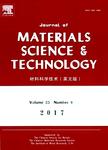Pomegranate-like ATO/SiO_(2)microspheres for efficient microwave absorption in wide temperature spectrum
作者机构:Institute of Functional Polymer CompositesCollege of Chemistry and Molecular SciencesHenan UniversityKaifeng 475004China National&Local Joint Engineering Research Center for Applied Technology of Hybrid NanomaterialsHenan UniversityKaifeng 475004China
出 版 物:《Journal of Materials Science & Technology》 (材料科学技术(英文版))
年 卷 期:2024年第174卷第7期
页 面:195-203页
核心收录:
学科分类:08[工学] 0805[工学-材料科学与工程(可授工学、理学学位)] 080502[工学-材料学]
基 金:the financial support of the National Nature Science Foundation of China(No.U1704253)
主 题:ATO/SiO_(2)microspheres Local eddy current Impedance matching Dielectric loss Microwave absorption
摘 要:High-performance microwave-absorbing materials(MAMs)should meet both impedance matching and attenuation ***,it is hard to maintain excellent microwave absorption(MA)per-formance at an elevated temperature because the reliance on impedance matching and dielectric loss about temperature mutually *** this work,the pomegranate-like antimony-doped tin dioxide(ATO)/silica dioxide(SiO_(2))spheres were fabricated via a simple spray drying *** the spheres were used as functional units and dispersed in the matrix,the corresponding composites exhibit an out-standing anti-reflection effect on ***,the unique pomegranate-like structure of the ATO/SiO_(2)spheres provides both the effective local eddy current and abundant heterogeneous interface,which therefore contribute harvest enhanced dielectric relaxation and improved absorption performance when compared with that of the corresponding ATO/SiO_(2)*** a result,the maximum re-flection loss of the ATO/SiO_(2)spheres composites can reach-47.8 dB at 9.7 GHz with a thickness of 1.8 mm,while the reflection loss could reach-47.3 dB at 573 K and the effective absorption bandwidth is 2.4 *** work reveals the importance of local eddy current loss in optimizing the electromagnetic wave(EMW)absorption performance and impedance matching,providing novel guidance on designing advanced high-temperature MAMs.



